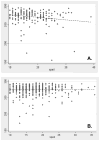Anxiety and optimism associated with gestational age at birth and fetal growth
- PMID: 19697113
- PMCID: PMC2996864
- DOI: 10.1007/s10995-009-0513-y
Anxiety and optimism associated with gestational age at birth and fetal growth
Abstract
Psychosocial factors such as anxiety or optimism may be related to the risk of adverse pregnancy outcomes, but the evidence is conflicting. We investigated the relation between maternal anxiety, optimism, gestational age and infant birth weight in a cohort of 667 nulliparous women from the Prenatal Exposures and Preeclampsia Prevention study, Pittsburgh PA. Women completed the Spielberger Trait Anxiety Inventory and the Life Orientation Test at 18 weeks gestation. Linear and logistic regression models assessed the relation of anxiety and optimism to gestational age, birth weight centile, preterm delivery (<37 weeks) or small for gestational age (<10th percentile) births. After adjustment for age, race, preeclampsia, and smoking, higher anxiety was associated with decreasing gestational age (-1.6 days per SD increase in anxiety score, P = 0.06). This relationship was modified by maternal race (P < 0.01 for interaction). Among African American women, each SD increase in anxiety was associated with gestations that were, on average, 3.7 days shorter (P = 0.03). African American women with anxiety in the highest quartile had gestations that were 8.2 days shorter, and they had increased risk for preterm birth after excluding cases of preeclampsia (OR 1.69, 95% CI 1.08, 2.64). There was no association between anxiety and gestational age among White women. There was also no relation between anxiety, optimism and birth weight centile. Trait anxiety was associated with a reduction in gestational age and increased risk for preterm birth among African American women. Interventions that reduce anxiety among African American pregnant women may improve pregnancy outcomes.
Figures
Similar articles
-
The relationship between race, inflammation and psychosocial factors among pregnant women.Matern Child Health J. 2015 Feb;19(2):401-9. doi: 10.1007/s10995-014-1522-z. Matern Child Health J. 2015. PMID: 24898691 Free PMC article.
-
Pregnancy outcomes in nulliparous women with positive first-trimester preterm preeclampsia screening test: the Great Obstetrical Syndromes cohort study.Am J Obstet Gynecol. 2021 Feb;224(2):204.e1-204.e7. doi: 10.1016/j.ajog.2020.08.008. Epub 2020 Aug 7. Am J Obstet Gynecol. 2021. PMID: 32777265
-
Maternal Prenatal Positive Affect, Depressive and Anxiety Symptoms and Birth Outcomes: The PREDO Study.PLoS One. 2016 Feb 26;11(2):e0150058. doi: 10.1371/journal.pone.0150058. eCollection 2016. PLoS One. 2016. PMID: 26919119 Free PMC article.
-
Omega-3 fatty acid addition during pregnancy.Cochrane Database Syst Rev. 2018 Nov 15;11(11):CD003402. doi: 10.1002/14651858.CD003402.pub3. Cochrane Database Syst Rev. 2018. PMID: 30480773 Free PMC article.
-
Risk of stillbirth, preterm delivery, and fetal growth restriction following exposure in a previous birth: systematic review and meta-analysis.BJOG. 2018 Jan;125(2):183-192. doi: 10.1111/1471-0528.14906. Epub 2017 Oct 3. BJOG. 2018. PMID: 28856792
Cited by
-
Pregnancy outcomes and anxiety in nulliparous women.J Matern Fetal Neonatal Med. 2022 Dec;35(25):8681-8690. doi: 10.1080/14767058.2021.1998441. Epub 2021 Nov 7. J Matern Fetal Neonatal Med. 2022. PMID: 34747312 Free PMC article.
-
Activity restriction among women with a short cervix.Obstet Gynecol. 2013 Jun;121(6):1181-1186. doi: 10.1097/AOG.0b013e3182917529. Obstet Gynecol. 2013. PMID: 23812450 Free PMC article.
-
Improving Prenatal Care for Minority Women.MCN Am J Matern Child Nurs. 2016 May-Jun;41(3):147-53. doi: 10.1097/NMC.0000000000000227. MCN Am J Matern Child Nurs. 2016. PMID: 26854915 Free PMC article.
-
Allostatic load in women with a history of low birth weight infants: the national health and nutrition examination survey.J Womens Health (Larchmt). 2014 Dec;23(12):1039-45. doi: 10.1089/jwh.2013.4572. J Womens Health (Larchmt). 2014. PMID: 25495368 Free PMC article.
-
The combined association of psychosocial stress and chronic hypertension with preeclampsia.Am J Obstet Gynecol. 2013 Nov;209(5):438.e1-438.e12. doi: 10.1016/j.ajog.2013.07.003. Epub 2013 Jul 11. Am J Obstet Gynecol. 2013. PMID: 23850528 Free PMC article.
References
-
- Steer P. The epidemiology of preterm labour. BJOG: An International Journal of Obstetrics & Gynaecology. 2005;1:1–3. - PubMed
-
- Institute of Medicine. Preterm Birth: Causes, Consequences, and Prevention. Washington, DC: 2006.
-
- Zeitlin J, Ancel P, Saurel-Cubizolles M, Papiernik E. Are risk factors the same for small for gestational age versus other preterm births. Am J Obstet Gynecol. 2001;185:208–15. - PubMed
-
- Fox S, Koepsell T, Daling J. Birth weight and smoking during pregnancy-effect modification by maternal age. Am J Epidemiol. 1994;139:1008–15. - PubMed
MeSH terms
Grants and funding
LinkOut - more resources
Full Text Sources
Medical


